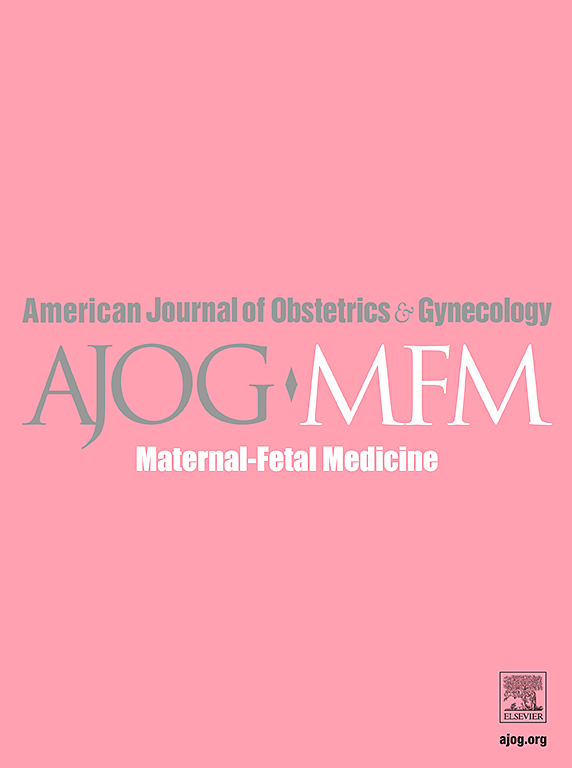Cost-effectiveness of exome sequencing and chromosomal microarray for low-risk pregnancies
IF 3.8
2区 医学
Q1 OBSTETRICS & GYNECOLOGY
American Journal of Obstetrics & Gynecology Mfm
Pub Date : 2025-02-01
DOI:10.1016/j.ajogmf.2024.101512
引用次数: 0
Abstract
BACKGROUND
Chromosomal microarray analysis (CMA) has been central to prenatal genetic diagnosis, detecting copy number variants with a ∼1% yield in low-risk cases. Next-generation sequencing (NGS), including exome sequencing (ES), enhances diagnostic capabilities with higher yields (8.5–10%) but at greater cost and complexity. While ES's cost-effectiveness is studied in high-risk pregnancies, data for low-risk pregnancies remain lacking. This study evaluates the cost-effectiveness of ES in low-risk pregnancies.
OBJECTIVE
This study aimed to investigate the cost-effectiveness of exome sequencing compared with chromosomal microarray analysis.
STUDY DESIGN
Costs, utilities, and quality-adjusted life years were modeled for prenatal testing with chromosomal microarray analysis or chromosomal microarray analysis + exome sequencing. Average costs and utilities were discounted at 3%. In addition, 2 strategies for screening were compared using the Markovian decision analysis model: (1) chromosomal microarray analysis only (an abnormal result leads to a termination of pregnancy, and a normal test has a 1 to 160 chance of developing into a severe disorder) and (2) exome sequencing after a normal chromosomal microarray analysis (a positive result leads to a termination of pregnancy). Of note, 1-way sensitivity analysis was performed for all variables. The outcome measures included quality-adjusted life years after abortion, costs of chromosomal microarray analysis and exome sequencing, and health expenses of a critically ill infant. The time horizon of the model was 20 years.
RESULTS
The total costs were $1348 for chromosomal microarray analysis and $3108 for chromosomal microarray analysis + exome sequencing. The quality-adjusted life years with a time horizon of 20 years were 14.15 for chromosomal microarray analysis and 14.19 for chromosomal microarray analysis + exome sequencing, with an incremental cost-effectiveness ratio of $46,383 per quality-adjusted life years. Sensitivity analysis revealed that the time horizon and the disutility of moderate/severe disability of the genetic disorder have an effect on the incremental cost-effectiveness ratio. For example, the incremental cost-effectiveness ratios are $84,291 per quality-adjusted life years for a relatively small disutility of moderate/severe disability and $94,148 per quality-adjusted life years for a shorter time horizon of 10 years.
CONCLUSION
Exome sequencing has the potential to be cost-effective compared with chromosomal microarray analysis alone. Our research provides data regarding the cost-effectiveness of exome sequencing without a specific indication, which will become increasingly important in the near future as whole exome sequencing becomes the first-tier test in prenatal diagnosis.
外显子组测序和染色体微阵列对低风险妊娠的成本效益:产前外显子组测序的成本效益。
目的研究外显子组和基因组测序 (ES) 与染色体微阵列 (CMA) 相比的成本效益 方法:对 CMA 或 CMA+ES 产前检测的成本、效用和质量调整生命年 (QALY) 进行建模。平均成本和效用的贴现率为 3%。使用马尔可夫决策分析模型对两种筛查策略进行了比较:(1)仅进行 CMA--异常结果最终导致终止妊娠,正常检查有 1/160 的几率出现严重疾病。(2)在 CMA 正常后进行 ES,如果结果为阳性,则终止妊娠(TOP)。对所有变量进行单向敏感性分析。结果衡量指标包括流产后的 QALY、CMA 和 ES 检测的费用以及重症婴儿的医疗费用。模型的时间跨度为 20 年:CMA 和 CMA+ES 策略的总成本分别为 1,348 美元和 3,108 美元。在 20 年的时间跨度内,CMA 和 CMA+ES 策略的 QALYs 分别为 14.15 和 14.19 QALYs,增量成本效益比 (ICER) 为 46,383 美元/QALYs。敏感性分析表明,时间跨度和遗传性疾病中度/重度残疾的无用性对 ICER 有影响。例如,如果中度/重度残疾的效用相对较小,则 ICER 为 84,291 美元/QALYs;如果时间跨度较短,为 10 年,则 ICER 为 94,148 美元/QALYs:与单纯的 CMA 相比,Exome 具有成本效益的潜力。我们的研究提供了有关无特定指征 ES 成本效益的数据,在不久的将来,随着全外显子组测序成为产前诊断的第一级检测,这些数据将变得越来越重要。
本文章由计算机程序翻译,如有差异,请以英文原文为准。
求助全文
约1分钟内获得全文
求助全文
来源期刊

American Journal of Obstetrics & Gynecology Mfm
Medicine-Medicine (all)
CiteScore
7.40
自引率
3.20%
发文量
254
审稿时长
40 days
期刊介绍:
The American Journal of Obstetrics and Gynecology (AJOG) is a highly esteemed publication with two companion titles. One of these is the American Journal of Obstetrics and Gynecology Maternal-Fetal Medicine (AJOG MFM), which is dedicated to the latest research in the field of maternal-fetal medicine, specifically concerning high-risk pregnancies. The journal encompasses a wide range of topics, including:
Maternal Complications: It addresses significant studies that have the potential to change clinical practice regarding complications faced by pregnant women.
Fetal Complications: The journal covers prenatal diagnosis, ultrasound, and genetic issues related to the fetus, providing insights into the management and care of fetal health.
Prenatal Care: It discusses the best practices in prenatal care to ensure the health and well-being of both the mother and the unborn child.
Intrapartum Care: It provides guidance on the care provided during the childbirth process, which is critical for the safety of both mother and baby.
Postpartum Issues: The journal also tackles issues that arise after childbirth, focusing on the postpartum period and its implications for maternal health. AJOG MFM serves as a reliable forum for peer-reviewed research, with a preference for randomized trials and meta-analyses. The goal is to equip researchers and clinicians with the most current information and evidence-based strategies to effectively manage high-risk pregnancies and to provide the best possible care for mothers and their unborn children.
 求助内容:
求助内容: 应助结果提醒方式:
应助结果提醒方式:


